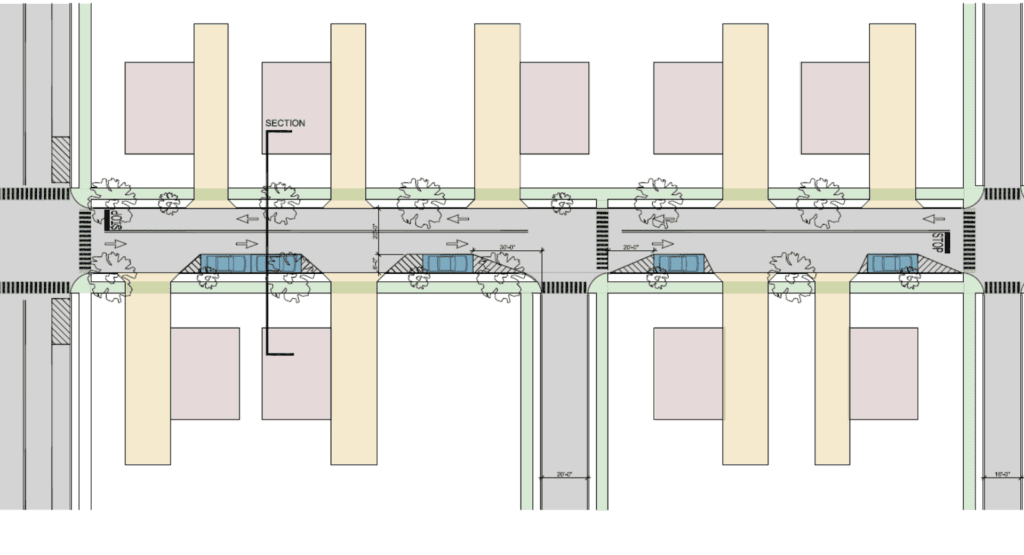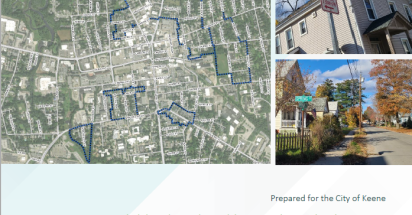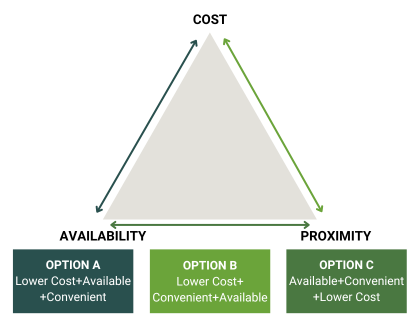


Neighborhood Parking Project Information
In the winter/spring of 2023 and 2024, the City used grant funding to explore sustainable parking and transportation options that will enable continued residential development in neighborhoods needed housing development.
How do residential parking programs work?
What is a Parking Benefit District?
The Parking Triangle (printable pdf)
KEY RECOMMENDATIONS & NEXT STEPS
The final report includes a number of recommendations related to the City’s on-street parking policies, zoning requirements, transportation demand management, communication/marketing and wayfinding, technology, and finance tools. The three recommendations that the City intends to explore in the near future are listed below.
Modify on-site parking requirements in zoning (lead: Community Development Department). The City of Keene generally requires two parking spaces per dwelling unit outside the downtown and either 1 space per unit or no parking in the downtown. This report recommends reducing the parking requirements citywide for senior housing and affordable housing and basing the requirement for multifamily housing on the number of bedrooms.
Replace the winter parking ban with an emergency weather parking ban (lead: Public Works Department). The City currently enforces a six-month winter on-street parking ban. Switching to an ad-hoc system where residents only have to move their vehicle during a weather event would eliminate the need for residents who park on-street to find alternative parking for half the year.
Update the Residential Parking Permit (RPP) Program (lead: Parking Services). The current RPP program was created to mitigate the impact of college student commuters on adjacent residential streets. This report recommends reviewing and updating the RPP regulations to ensure the program will best serve the needs of residents in areas where spillover from commercial or institutional uses limits the amount of parking available for resident use.
premium price. Parking facilities that are low-cost or free and consistently have available spaces are likely not conveniently located.
Meetings & Updates
Past Meetings
Public Open House – Wednesday, January 24th, 2023, 3:30 PM to 5:30 PM at the Keene Public Library in Heberton Hall, 60 Winter Street
View The Presentation Slides – The project was also presented to the City Council’s MSFI Committee, including how expanded parking options relate to potential housing solutions.
Presentation – Monday, June 10, 2024 at 6:30 PM in the second floor Council Chambers of City Hall, 3 Washington Street.
A brief overview of the project and draft recommendations that pertain to zoning will be presented at the Joint Committee of the Planning Board and the Planning, Licenses, and Development Committee.
Community Night – Tuesday, June 18, 2024 from 4:00-7:00 PM, 350 Marlboro Street.
The project consultant will be present at the City of Keene Community Night at the Parking Operations station to provide information about the draft report and recommendations.
Timeline
January 2024: Open House For Public Input (1/24/2024), Stakeholder Interviews, Online Survey, City Council MSFI Committee Discussion
February-March 2024: Analysis & Draft Recommendations
April 2024: Open House To Review Recommendations, Stakeholder Input, City Council MSFI Committee Discussion
May-June 2024: Formalize Recommendations, City Council Presentation
Further Information
large, the most desirable and convenient parking is almost always the curbside parking in front of a residence or business. Applying natural market forces and charging market-rate prices, particularly for curbside parking, ensures enough turnover that a driver can always find a spot. As new development is realized in the residential neighborhoods closest to Keene’s downtown core, a more focused approach to the management of curbside parking may be necessary. While there are a wide variety of policy, program, and infrastructure strategies that municipalities and parking operators can employ, Parking Benefit Districts and Residential Parking Programs are two potential tools Keene could consider.
How Do Residential Parking Programs Work?
Residential parking permit programs (sometimes abbreviated RPPs) are used to restrict parking in residential areas to those residents who live nearby. The primary purpose of residential parking permit programs is to mitigate spillover parking demand into residential neighborhoods from adjacent commercial or institutional uses, or when historic land development has limited the amount of parking available in residential areas. Residential parking permits allow residents with permits to overstay posted time limits in managed on-street areas. Those without residential permits must abide by posted time limits or risk a citation.
While RPP participants have traditionally been identified with either a sticker or hangtag, more modern systems have transitioned to a virtual permit management system and use the resident’s license plate as the credential. Enforcement can then be performed with a mobile license plate reader, which increases the efficiency of enforcement operations. The details of the program can be tailored to meet the goals of the neighborhood and the local restrictions of the community.
What is Parking Benefit District?
A Parking Benefit District (“PBD”) is just one parking management tool used to garner support for “right-priced” parking. With a PBD, the local government designates an area in which the revenue from meters (and/or permits) is reinvested in the area to support public services and fund local improvements. However, public services and improvements don’t need to be limited to building more parking. Government can invest the revenues collected in the PBD into projects that increase walkability, improve safety, promote multi-modal access, and support local micro-transit systems. PBDs allow everyone who lives, works, visits, or owns property in a PBD to see their money at work. And, when successful, they reduce the need to park or repark in the area, further reducing congestion and calming traffic. They can even be used to promote equity across the larger community by splitting revenues between the PBD and the city. Sharing PBD revenue citywide provides funding for multi-modal access throughout the community, ultimately making the city more accessible and less dependent on single occupancy vehicles.
The Parking Triangle – Understanding Parking Management Practices

When managing a parking system, the logic is to control parking demand by pricing the most convenient and desirable parking higher than less convenient parking locations. This practice is best represented by the “parking triangle” of cost, availability, and proximity (convenience).
Parking customers want the following when seeking parking:
- They want it to be free
- They want it to be always available
- They want it to convenient or proximate to their destination.
In a thriving area, it is possible for customers to have two of these three criteria met, but it is not possible to have all three met at the same time. Following the laws of market economics, conveniently located facilities that have available spaces typically come at a premium price. Parking facilities that are low-cost or free and consistently have available spaces are likely not conveniently located.

